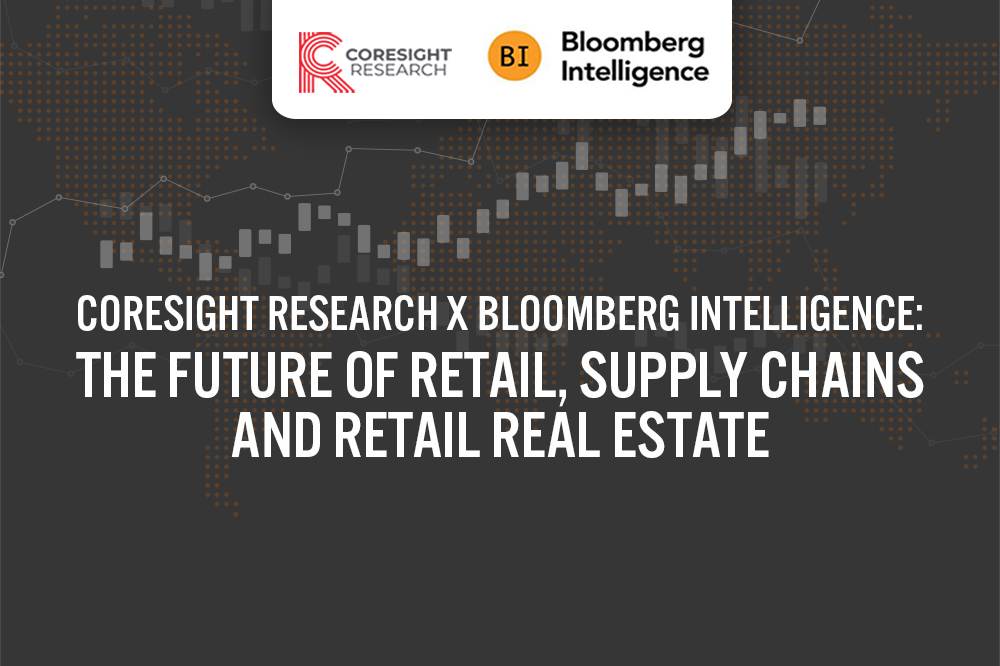
DIpil Das
Coresight Research partnered with Bloomberg Intelligence to host a series of digital panel discussions on July 28, 2020, exploring the future of retail, supply chain management and retail real estate in the new normal post Covid-19. Deborah Weinswig, CEO of Coresight Research, and Bloomberg Intelligence Senior Retail Analyst Poonam Goyal co-hosted the event, which brought together a group of thought leaders with expertise across the retail industry. We summarize the key insights from the panels.
1. Luxury Brands Are Beginning To Embrace Digital Channels
In the first panel of the day, Goyal highlighted some significant bright spots in both physical and digital retail, in discussion with Marie Driscoll, Managing Director, Luxury and Fashion at Coresight Research; Helen Olba, CEO of Urban Zen; and Rich Wagner, CEO of Prevedere.
Luxury spending has been hit particularly hard by the recent economic downturn, but Driscoll noted that the closing of physical stores has spurred luxury brands to embrace technology to develop better digital shopping experiences. Young Chinese consumers have typically been a market for global luxury brands, and this is increasingly becoming the case as this demographic generally prefers digital shopping to the physical retail experience. Fashion brands have therefore increased their investment into digital channels to futher engage with Chinese consumers and boost sales.
Driscoll emphasized that 30% of US shoppers’ luxury spend is on purchases made while traveling abroad, according to a survey by Coresight Research, so restrictions on traveling internationally may increase domestic sales of luxury goods in the coming months. Driscoll predicts luxury brands that practice digital clienteling may see increased US spending in the coming months.
Olba highlighted the importance of experiential retail in fashion. Luxury lifestyle brand Urban Zen tailors each of its stores to its location: The company’s Los Angeles location is focused on health and wellness; its New York location hosts art exhibits; and its Sag Harbor location includes a restaurant to promote a cozy neighborhood ambience. Despite current restrictions on physical shopping and dining, Olba remains confident that customized, experience-based shopping experiences are the future of retail.
[caption id="attachment_113800" align="aligncenter" width="700"] Poonam Goyal (left); Helen Olba (right)
Poonam Goyal (left); Helen Olba (right)
Source: Coresight Research [/caption] Both Olba and Wagner agreed that embracing technology is key for retailers to be able to navigate swift changes in the retail landscape. Customer experiences that are powered by augmented and virtual reality technologies may be the most innovative changes to retail to come out of the pandemic; these technologies can improve the shopping experience both in store and digitally. Wagner also cited the importance of mobile data in helping retailers adapt to changing shopping habits. Mobile point-of-interest data that provides detailed tracking of customer movements gives retailers the ability to adjust to new trends quickly by mapping store traffic and time spent at retail locations, as well as pinpointing whether customers enter the store or utilize drive-thru or curbside-pickup options. 2. The Retail Real-Estate Landscape Is Shifting Quickly, and Online Shopping Demographics and Habits Are Changing Weinswig hosted James Cook, Director of Research at JLL, Lindsay Dutch, REIT analyst at Bloomberg Intelligence, and John Crombie, Executive Managing Director at Cushman and Wakefield, to discuss how the retail real-estate and online shopping environments have been shifting during the pandemic. Much of the discussion focused on what uses will be found for retail spaces vacated by department stores and traditional mall tenants. All panelists agreed that some former big-box stores would be converted into warehouses and fulfillment centers. However, Dutch cautioned that this transition will not be a quick or seamless one. Warehouses and fulfillment centers are much less desirable venues for the communities they are in, and in some instances, companies may face pushback from communities and local governments as they attempt to repurpose these facilities. Micro-fulfillment centers that leverage robotics could be a solution for some retailers who are unable to convert larger spaces into fulfillment centers, particularly for retailers whose inventory does not vary much over the course of the year. Both Cook and Crombie highlighted that many of the vacancies in malls will be small-box stores, vacated by retailers with fewer resources that were unable to survive the economic downturn. These retail spaces may be the ideal size for digitally native brands to test out having a brick-and-mortar presence, but Cook cautioned that online brands’ lack of experience running physical stores may make this transition difficult. He cited Leap, a company that offers a turnkey service for digitally native brands to open physical locations, as a possible facilitator of this change. However, Cook and Crombie believe that the amount of national retail square footage will decrease, with Crombie predicting that post pandemic, retailers will look for quality over quantity in their real-estate search, creating a glut of unused low-quality retail space. Landlords will have to explore more creative uses for large plots of unused real estate, such as creating dog parks or drive-in movie theaters. [caption id="attachment_113801" align="aligncenter" width="700"] Deborah Weinswig (top left); James Cook (top right); Lindsay Dutch (bottom left); John Crombie (bottom right)
Deborah Weinswig (top left); James Cook (top right); Lindsay Dutch (bottom left); John Crombie (bottom right)
Source: Coresight Research [/caption] Panelists also discussed how online shopping has shifted during the pandemic, and what trends they expect to continue when normal life resumes. While Cook acknowledged that it is common knowledge that online shopping has increased dramatically during the pandemic, he questioned how much of this increase would carry over to the post-pandemic world. Much of the recent increase in online shopping has been driven by “begrudging” online shoppers, particularly men aged over 55 years, who previously mostly shopped at physical retail locations. Cook still expects online shopping to remain higher than pre-pandemic levels, but cautioned that he does not expect it to maintain an increase of 50% or higher. What people are buying online has also shifted during the pandemic. Crombie identified home improvement, health food, and sportswear and leisure wear as categories that are doing especially well as many people continue to spend more time at home and exercise outdoors (rather that in gyms). Panelists offered varying predictions for 2021. Cook forecasted that when a vaccine is widely available, restaurants and physical retailers left standing will see an almost unprecedented boom in business, and experience-based retail will return to the forefront. Crombie agreed, but with the caveat that retailers will need to cull underperforming locations and use artificial intelligence to create smarter stores in order to survive the pandemic. Dutch cautioned that vacancy rates will likely be higher than this year, perhaps slowing the recovery of physical retail. 3. Suppliers and Retailers Are Streamlining the Supply Chain and Improving the Online Shopping Experience Weinswig also hosted the final panel of the day, which focused on how the pandemic has hastened the development of new technologies to increase supply-chain efficiency. Whitney Cathcart, Cofounder and CSO of 3DLook; JoAnn Martin, SVP of Retail at Blue Yonder; Anurag Rana, Bloomberg Senior Tech Analyst; and Sue Welch, CEO of Bamboo Rose, joined the discussion about the future of the supply chain in the post-pandemic era. Panelists highlighted the need for integrated supply-chain systems to facilitate data sharing and transparency across all levels of production and distribution. Rana and Welch both emphasized how blockchain and other supply-chain technologies ensure that manufacturers and suppliers are producing their goods ethically and efficiently. Rana predicted that companies that invest heavily in technology and cloud computing that binds together front, middle and back-office operations will be the ones to thrive through the pandemic. Welch agreed, while also indicating that blockchain will help retailers to assuage consumer concerns about the sourcing and authenticity of their products—by using multi-enterprise supply-chain platforms (such as offered by Bamboo Rose), where all contributors cross-validate data on production and fulfillment. Martin argued that retail sales will rebound exponentially after the pandemic, claiming that consumers have not stopped buying clothes, they have just begun buying them differently. The pandemic has accelerated the adoption of 3D rendering technologies and customers trying clothes on digitally. Cathcart emphasized the importance of 3D technology to streamline clothing design and production. 3D rendering technology is also an increasingly valuable consumer-facing tool in online shopping. Cathcart noted that 70% of returns are related to fitting issues. 3DLook enables customers to create a digital avatar complete with their height, weight, and measurements that they can then use to “try on” clothes online. This technology can also be used to customize the fit of clothing, and Cathcart believes that retailers that give consumers the option to design custom-fit clothing are well positioned to thrive. Eventually, all aspects of fashion production may be customizable, including fit, design and even the location and method of production. Martin noted that partnerships and mergers and acquisitions will be key to integrating this technology effectively. The logistics of 3D design, sampling and fulfillment are complex, making acquisitions such as Blue Yonder’s acquisition of Yantriks (a provider of commerce and fulfillment microservices) vital to success. What We Think Over the past several months, the coronavirus pandemic has led to vast changes in the retail landscape. Many of these changes will likely last even after the pandemic: 3D rendering, augmented reality software and blockchain technology will remain critical in streamlining the supply chain, and digital tools to improve the online shopping experience are here to stay. Experiential retail is on pause, but some industry leaders expect it to thrive again once the industry settles into the new normal and safety is no longer the primary priority. As the retail real-estate environment continues to evolve, some former big-box stores will be converted into warehouses and fulfillment centers, and vacant small-box stores may be suitable venues for digitally native brands to expand into brick-and-mortar retail. However, there will likely be an overall reduction in retail square footage next year.
 Poonam Goyal (left); Helen Olba (right)
Poonam Goyal (left); Helen Olba (right) Source: Coresight Research [/caption] Both Olba and Wagner agreed that embracing technology is key for retailers to be able to navigate swift changes in the retail landscape. Customer experiences that are powered by augmented and virtual reality technologies may be the most innovative changes to retail to come out of the pandemic; these technologies can improve the shopping experience both in store and digitally. Wagner also cited the importance of mobile data in helping retailers adapt to changing shopping habits. Mobile point-of-interest data that provides detailed tracking of customer movements gives retailers the ability to adjust to new trends quickly by mapping store traffic and time spent at retail locations, as well as pinpointing whether customers enter the store or utilize drive-thru or curbside-pickup options. 2. The Retail Real-Estate Landscape Is Shifting Quickly, and Online Shopping Demographics and Habits Are Changing Weinswig hosted James Cook, Director of Research at JLL, Lindsay Dutch, REIT analyst at Bloomberg Intelligence, and John Crombie, Executive Managing Director at Cushman and Wakefield, to discuss how the retail real-estate and online shopping environments have been shifting during the pandemic. Much of the discussion focused on what uses will be found for retail spaces vacated by department stores and traditional mall tenants. All panelists agreed that some former big-box stores would be converted into warehouses and fulfillment centers. However, Dutch cautioned that this transition will not be a quick or seamless one. Warehouses and fulfillment centers are much less desirable venues for the communities they are in, and in some instances, companies may face pushback from communities and local governments as they attempt to repurpose these facilities. Micro-fulfillment centers that leverage robotics could be a solution for some retailers who are unable to convert larger spaces into fulfillment centers, particularly for retailers whose inventory does not vary much over the course of the year. Both Cook and Crombie highlighted that many of the vacancies in malls will be small-box stores, vacated by retailers with fewer resources that were unable to survive the economic downturn. These retail spaces may be the ideal size for digitally native brands to test out having a brick-and-mortar presence, but Cook cautioned that online brands’ lack of experience running physical stores may make this transition difficult. He cited Leap, a company that offers a turnkey service for digitally native brands to open physical locations, as a possible facilitator of this change. However, Cook and Crombie believe that the amount of national retail square footage will decrease, with Crombie predicting that post pandemic, retailers will look for quality over quantity in their real-estate search, creating a glut of unused low-quality retail space. Landlords will have to explore more creative uses for large plots of unused real estate, such as creating dog parks or drive-in movie theaters. [caption id="attachment_113801" align="aligncenter" width="700"]
 Deborah Weinswig (top left); James Cook (top right); Lindsay Dutch (bottom left); John Crombie (bottom right)
Deborah Weinswig (top left); James Cook (top right); Lindsay Dutch (bottom left); John Crombie (bottom right) Source: Coresight Research [/caption] Panelists also discussed how online shopping has shifted during the pandemic, and what trends they expect to continue when normal life resumes. While Cook acknowledged that it is common knowledge that online shopping has increased dramatically during the pandemic, he questioned how much of this increase would carry over to the post-pandemic world. Much of the recent increase in online shopping has been driven by “begrudging” online shoppers, particularly men aged over 55 years, who previously mostly shopped at physical retail locations. Cook still expects online shopping to remain higher than pre-pandemic levels, but cautioned that he does not expect it to maintain an increase of 50% or higher. What people are buying online has also shifted during the pandemic. Crombie identified home improvement, health food, and sportswear and leisure wear as categories that are doing especially well as many people continue to spend more time at home and exercise outdoors (rather that in gyms). Panelists offered varying predictions for 2021. Cook forecasted that when a vaccine is widely available, restaurants and physical retailers left standing will see an almost unprecedented boom in business, and experience-based retail will return to the forefront. Crombie agreed, but with the caveat that retailers will need to cull underperforming locations and use artificial intelligence to create smarter stores in order to survive the pandemic. Dutch cautioned that vacancy rates will likely be higher than this year, perhaps slowing the recovery of physical retail. 3. Suppliers and Retailers Are Streamlining the Supply Chain and Improving the Online Shopping Experience Weinswig also hosted the final panel of the day, which focused on how the pandemic has hastened the development of new technologies to increase supply-chain efficiency. Whitney Cathcart, Cofounder and CSO of 3DLook; JoAnn Martin, SVP of Retail at Blue Yonder; Anurag Rana, Bloomberg Senior Tech Analyst; and Sue Welch, CEO of Bamboo Rose, joined the discussion about the future of the supply chain in the post-pandemic era. Panelists highlighted the need for integrated supply-chain systems to facilitate data sharing and transparency across all levels of production and distribution. Rana and Welch both emphasized how blockchain and other supply-chain technologies ensure that manufacturers and suppliers are producing their goods ethically and efficiently. Rana predicted that companies that invest heavily in technology and cloud computing that binds together front, middle and back-office operations will be the ones to thrive through the pandemic. Welch agreed, while also indicating that blockchain will help retailers to assuage consumer concerns about the sourcing and authenticity of their products—by using multi-enterprise supply-chain platforms (such as offered by Bamboo Rose), where all contributors cross-validate data on production and fulfillment. Martin argued that retail sales will rebound exponentially after the pandemic, claiming that consumers have not stopped buying clothes, they have just begun buying them differently. The pandemic has accelerated the adoption of 3D rendering technologies and customers trying clothes on digitally. Cathcart emphasized the importance of 3D technology to streamline clothing design and production. 3D rendering technology is also an increasingly valuable consumer-facing tool in online shopping. Cathcart noted that 70% of returns are related to fitting issues. 3DLook enables customers to create a digital avatar complete with their height, weight, and measurements that they can then use to “try on” clothes online. This technology can also be used to customize the fit of clothing, and Cathcart believes that retailers that give consumers the option to design custom-fit clothing are well positioned to thrive. Eventually, all aspects of fashion production may be customizable, including fit, design and even the location and method of production. Martin noted that partnerships and mergers and acquisitions will be key to integrating this technology effectively. The logistics of 3D design, sampling and fulfillment are complex, making acquisitions such as Blue Yonder’s acquisition of Yantriks (a provider of commerce and fulfillment microservices) vital to success. What We Think Over the past several months, the coronavirus pandemic has led to vast changes in the retail landscape. Many of these changes will likely last even after the pandemic: 3D rendering, augmented reality software and blockchain technology will remain critical in streamlining the supply chain, and digital tools to improve the online shopping experience are here to stay. Experiential retail is on pause, but some industry leaders expect it to thrive again once the industry settles into the new normal and safety is no longer the primary priority. As the retail real-estate environment continues to evolve, some former big-box stores will be converted into warehouses and fulfillment centers, and vacant small-box stores may be suitable venues for digitally native brands to expand into brick-and-mortar retail. However, there will likely be an overall reduction in retail square footage next year.